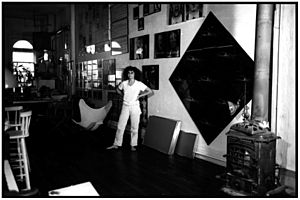Barbara Rosenthal facts for kids
Quick facts for kids
Barbara Rosenthal
|
|
|---|---|

Barbara Rosenthal in her New York City studio in 1990.
|
|
| Born |
Barbara Ann Rosenthal
1948 (age 76–77) |
| Nationality | American |
| Education | Brooklyn Museum Art School, Art Students League, Carnegie-Mellon University, Tyler School of Art in Rome, New York University Institute of Art History, City University of New York |
| Known for | Avant-garde art, writing, performance, photography |
|
Notable work
|
Journal: Volumes 1-71, Homo Futurus, Surreal Photography, Conceptual Photography, Provocation Cards, Existential Cartoons. |
Barbara Ann Rosenthal (born 1948) is an American artist, writer, and performer. She is known for creating avant-garde art, which means her work is new, experimental, and different from what is usually seen. She is also a conceptual artist, meaning the idea behind her art is the most important part.
Rosenthal's art often mixes different things, like X-rays, brain scans, and words from her personal journals. Her work explores big questions about life and what it means to be human. In 2021, Queens College acquired her entire collection of work to preserve it for the future.
She has sometimes used other names for her art, like Homo Futurus, which means "Future Human" in Latin. She also used the name Cassandra-on-the-Hudson, which connects to themes in her work. Rosenthal lives and works in New York City.
Contents
Early Life and Education
Barbara Rosenthal was born in The Bronx, New York, in 1948. When she was only 11 years old, she wrote a weekly column for her local newspaper, showing her talent for writing at a young age.
Rosenthal studied art at many famous schools. She went to the Brooklyn Museum Art School and later earned a Bachelor of Fine Arts degree from Carnegie-Mellon University. She also studied art in Rome, Italy, for a year. In 1974, she received her Master of Fine Arts degree from Queens College.
During her time as a student, she worked several jobs. She was a photojournalist for newspapers like The Village Voice and also worked as a dancer in clubs in Times Square.
Career as an Artist and Teacher
Rosenthal has taught art at many colleges, including the College of Staten Island, The School of Visual Arts (SVA), and Parsons School of Design. She has taught subjects like photography, video, painting, and art history.
In 1982, she co-founded the Museum of Modern Media with video artist Bill Creston. This organization was created to support new and experimental media art.
Art and Ideas
Rosenthal's art is very unique and often makes people think. She creates art in many forms, including writing, performance, photography, and video.
Writing
As a writer, Rosenthal creates short, clever sayings called aphorisms, as well as poems, stories, and essays. Many of her sayings are about time and reality. She prints them on "Provocation Cards" and hands them out for free during her performances.
Her stories often take place in strange, surreal worlds where a single person has to deal with confusing situations. She believes that art should be about exploring ideas, not just supporting a political or social cause.
Performance Art
Rosenthal's performance art uses a mix of installations, projections, sound, and music. These performances explore ideas about who we are as individuals.
In one project, she traveled to cities like New York, Berlin, and Paris wearing shirts covered in her art and handing out her "Provocation Cards." She also used "Identity Theft Masks," which were masks of her own face, to make people think about identity.
Photography
Rosenthal is known for her special style of photography, which she calls Surreal Photography. Her photos often show dreamlike scenes that tell a psychological story.
For many years, she only used black and white film, which she developed herself in a darkroom. Since 2006, she has also worked with color photography. Her photos are often grouped into themes like Trapped Figures, Tiny Houses, and Strange Neighborhoods.
Video Art
Since 1976, Rosenthal has created over 100 videos. As technology changed, she used different formats, from old-fashioned open-reel tapes to modern HD video.
Her videos often play with rhythm, repetition, and sound to create a feeling of tension or endurance. She has worked with other artists on her video projects, including Bill Creston in New York and DJ RoBeat in Berlin.
Art Philosophy
Rosenthal has a clear set of rules for her art. She believes that art should be simple and use as few materials as possible. She wants her work to look different from every angle and make viewers think.
Some of her main ideas include:
- A work of art should always have a sense of mystery.
- It should not try to tell people what to think.
- It should be original and not copy past successes.
- It should be available for everyone to see.
Major Collections and Awards
Rosenthal's art is part of major collections around the world. In the United States, her work is held by The Museum of Modern Art and The Whitney Museum of American Art. In Europe, her art can be found at the Tate Britain Library in London.
She has received many awards and grants for her work. In 2013, the New Museum in New York helped archive her media art to preserve it for the future. She has also received grants that allowed her to live and work as an artist in places like Beijing, China.
Selected Works
Rosenthal has published several books that combine her writing and images.
Books
- Clues to Myself (1981)
- Homo Futurus (1986)
- Sensations (1984)
- Soul & Psyche (1998)
- Weeks (1990), a book created with poet Hannah Weiner.
Other Publications
- Existential Cartoons (2007)
- Old Address Book (1984)
- Structure And Meaning (1981)

